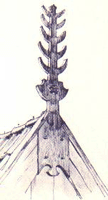

Architecture
The architecture in Friland is mostly aimed at comfort, practical use and beauty. Especially the native, traditional styles and variations on "old-fashioned" building styles like Gothic and Jugendstil are popular.
Building styles
The most common building styles are as follows:
Aldbu ("Old build"): the traditional style that already exists since the Iron Age. It is characterized by large, reed roofs that almost extend to the ground. The walls are usually daub and wattle and smeared with clay. Modern variations of this style have tiled roofs or imitation reed that is fireproof and has better insulation. Brick walls, double glass and other modern inventions are also usual these days.
Haimbu ("Home build"): native style with a romantic nature that was developed in the 17th century. Characteristic are the decorations, little towers, elevations, stairs and the combination of buildings with water, trees or other natural elements.
Helbu ("Harmony build"): extreme carry through of the Haimbu, in which the surrounding area is not adapted to the new houses, but the new houses to the surrounding area. Trees for example, are not removed but the houses are built around them, which creates indoor gardens. A small stream will not be moved but used in the new plan, in which houses will stand half in the water and come with a jetty, or are even built over the stream like a bridge.
Gautanbu ("Goths build"): the Gothic building style, which was very popular in Friland, left many Neogothic variations in which buildings are still constructed.
Jugunşbu ("Youth build"): Jugendstil, also known as Art Nouveau, is still very popular in Friland and exists there in many different modern variations.
Allandbu ("International build"): fast, cheap, mutually different building styles with a usually common appearance. The terraces, apartments and office buildings that you can find in almost every country are all counted amongst these styles, for which "Allandbu" is a sort of generic name. The Allandbu is, like in every country, also the most common style in Friland.
Neubu ("New build"): the modern, prefab building style with much concrete, glass and brick as you see them in every new housing estate. In Friland these buildings are also called "soulless blocks of concrete", but because of its cheap, effective construction an increasing number of architects chooses to build in this style.
Examples of building styles in Friland, successively: Haimbu, Aldbu, Helbu and Neubu.

Traditions
When building a house it is customary to bring a "building offering" for good luck, this is usually done by placing a coin under the foundation or the doorstep.
 It is also believed that every house has a "huswiht" (house wight, house spirit) that protects the family against ill. When moving to another house people usually say a solemn farewell to the old spirit and will try to conciliate the spirit of the new house.
It is also believed that every house has a "huswiht" (house wight, house spirit) that protects the family against ill. When moving to another house people usually say a solemn farewell to the old spirit and will try to conciliate the spirit of the new house.
Other protection for the house and its inhabitants are thunder brooms: the thunder broom is a metal wall anchor in the shape of a hammer (upside-down T) or an Old Norse hagal rune (vertical line with diagonal cross through it), this symbol is associated with the god Şunar and protects against thunder and lightning.
In the peak of the roof, especially on farms, one often finds a gable sign. This consists of multiple symbols like a half moon, sun wheel, oşal rune, swan, horse, heart or tree of life. These symbols have different meanings, amongst these are fertility and protection against evil spirits.

|